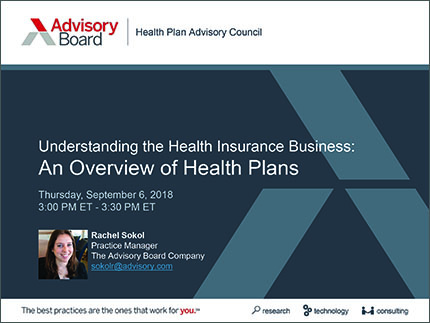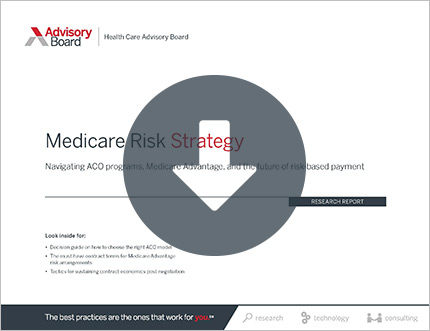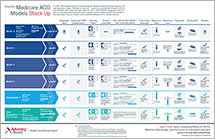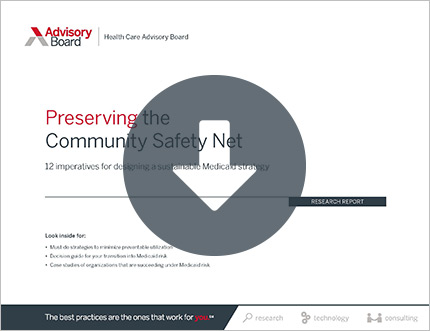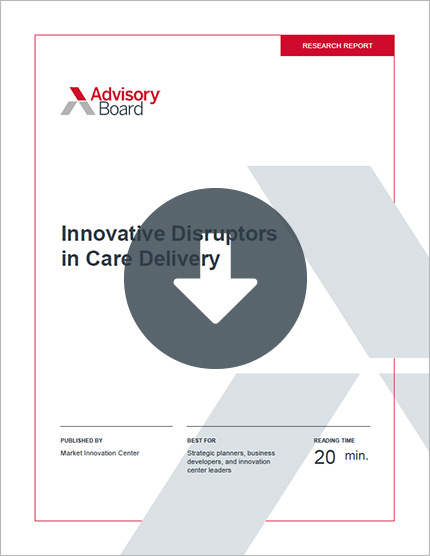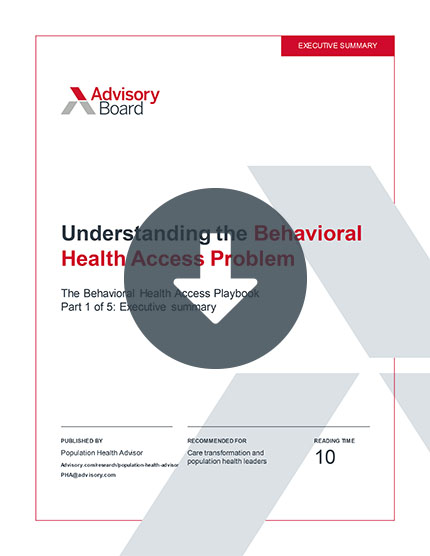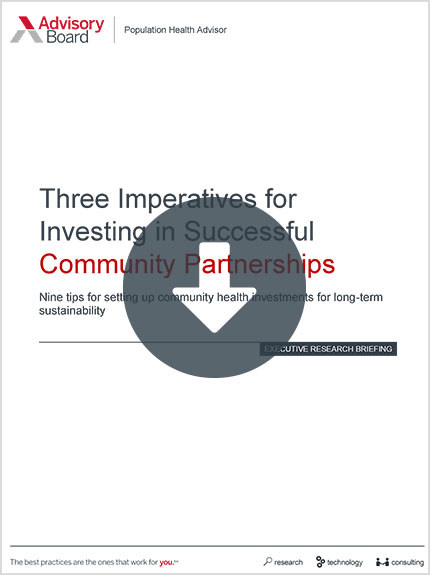Auto logout in seconds.
Continue LogoutWelcome to the "Lessons from the C-suite" series, featuring Advisory Board President Eric Larsen's conversations with the most influential leaders in health care.
In this edition, Patrick Conway, president and CEO of Blue Cross Blue Shield North Carolina, talks about the "biggest change in the Blues system in more than 20 years," the family "mission statement" behind his career choices, and how he's challenging the industry on health care transformation—with an unprecedented model of two-sided risk.

Patrick Conway, president and CEO of Blue Cross Blue Shield North Carolina
Question: Patrick, as I was brushing up on your history, I was struck by the sheer number of dimensions you can bring to a given problem. You've got the consultancy perspective with your McKinsey background; the academic, with 100 publications to your name; the clinical, with your work at Cincinnati Children's and Children's National; the government, working as a White House Fellow and later holding two directorships at CMS; and now you've added the payer side, helming Blue Cross Blue Shield North Carolina. That's five different perspectives—and you're still younger than me, which is mildly annoying.
The scale of the platform is remarkable: At CMS and CMMI, you were responsible for activities that touched more than 100 million lives, and the Blues collectively have 106 million lives—including the 4 million or so in North Carolina. I'd love your reflections on affecting transformation from all these different vantage points.
Patrick Conway: You know Eric, I was running quality measurement and innovation at Cincinnati Children's when Don Berwick, who hired me for CMS, basically said what you said: The platform here is huge. He said, "I love Cincinnati Children's, and you could stay there, but there's no other platform like this one."
So the pro there was just the enormous scale. Between 2012 and 2016, we went from having 0% of payments in alternative payment models (APMs) to having more than 30%—that represents more than 200,000 signed provider agreements across the country and more than $200 billion. I think Don pointed out that our team actually drove the most change in Medicare payment ever in history. But the cons of government are what you'd imagine: It's hard to hire people, and no model ever came out the exact way I wanted and everything took too long.
Fast forward to Blue Cross North Carolina: I don't know that Blues plans are known as being the most innovative or the quickest, but we can move so much faster, executing on ideas within weeks or months. And like you said, we insure 4 million members, including the majority of the state’s commercial market. So we can shift the trajectory of the state without nearly so much of the process fatigue we faced at CMS.
Q: Let's rewind a bit here. When you and I met after you departed CMMI, you were considering an array of different private-sector leadership roles. What sold you on BCBS North Carolina? If I'm not mistaken, you're the first practicing physician to run a Blues' plan—in fact, the first physician ever to run any brand of health plan of this size.
Conway: That is my understanding. Yes. And it's funny because when I was recruited for the role, my recruiter told me all these precedents, and then she added, "Don't f--- it up."
Q: Sound advice.
Conway: Agreed. But like you said, I'd looked at some health system CEO jobs and other things, but I realized that as a health system, if you didn't have good payer partners, it would be hard to really change the paradigm for a large population. And as a payer, we're basically trying to build a virtually integrated system with all these health systems and doctors and others—we're able to do that and really drive change across an entire state's population.
Q: So you concluded the payer position was essentially the better seat to effect industry transformation.
Conway: I did, yeah. And you'll laugh at this, Eric, but when I interviewed for the job I said two things: "One, if you want a regular health insurance executive, you should hire someone else. And two, you could probably hire someone who's better than me on the first month or the first year, but if you want somebody who's going to get better all the time and drive change in this state and try to be a model of what's possible, then you should hire me."
And also, I've had the same five criteria for jobs for about 20 years now, based on our family's mission statement. One is family; I'm married with four kids. Two is impact, which is the triple aim—better care, lower cost, and exceptional experience. Three is whether I'll learn on the job. Four is people, which early on was mentors and is now people and culture. And five is joy in work. They sound really simple, but they've actually centered me on various decisions for career and family.
Q: I love this. What did you put in the family mission statement?
Conway: I can't divulge the whole family mission statement—sworn to secrecy—but I'll give you the highlights. My wife Heather comes from a family of missionaries, so the mission statement talks about public service, service to your community and underserved populations, and about faith, which is important to both of us. At first, I was a little skeptical, but, as with most things, she was right.
North Carolina as the epicenter of national transformation
Q: You're now 23 months into the role. Reflections and observations so far?
Conway: I will tell you these first 23 months have been terrific, they've exceeded expectations. When I interviewed for the job, and really for the first three to six months on the job, the strategy was to be a model Blue. But we're actually expanding on that now to be a model of health transformation—a model of what's possible—because we think it's bigger than just the health plan.
So our mission is to improve the health of the people and communities we serve. And our vision for getting there is to work with others in the state to drive health transformation to achieve better quality, lower cost, and exceptional experience. And then we have seven strategic pillars that we're executing on, things like data and analytics, value and quality. But people come first, because you've got to focus on your people before you can provide exceptional experience, develop operational excellence, and drive profitable growth, especially through Medicaid and Medicare. In fact, in terms of operational excellence, we actually took $50 million of cost out last year, and we'll take out another $60 million or more this year.
We've been removing waste from our system. And for us as a nonprofit health plan, if you think about premiums, 85% of our cost is medical cost, so bringing that down has got to be the main focus. But about 12% of our cost is administrative, so we've also had to think about that. And using LEAN and other methodologies, we've trimmed over $100 million which lowers premiums for employers and individuals.
Q: I'd like your view, Patrick, on the unique character of North Carolina health care. You've got a little bit of everything happening—the unprecedented move of a for-profit into the market with HCA acquiring Mission Health; a controversial reference pricing proposal floated by the state plan; the state's move to managed Medicaid this year; some emerging nonprofit mergers, including Atrium and Wake Forest Baptist; and you've launched Blue Premier, which is notable for its move to two-sided risk. Come to think of it, I'm hard-pressed to think of any other state in the union with this degree of transformation and disruption. What's in the water in North Carolina?
Conway: A couple of thoughts here. One, we've got the right set of players. For instance, North Carolina's Secretary of Health Mandy Cohen is driving Medicaid managed care to address drivers of health and value. And that matters, because it means we've got a public partner who's driving in the same direction. We've also got the health system CEOs in the state who want to go in that direction too. We've also got a pretty robust set of independent primary care providers driving population health and specialty groups that we do bundles with that are saving 20% or more, with better quality and better experience.
And two, North Carolina is generalizable to the rest of the country, right? We've got urban, we've got rural, we've got disparity issues, we've got 10 million people—basically, if you succeed in North Carolina, it can be a model of what's possible for the nation. So expectations are high; people are watching North Carolina, and we've got drive change and execute on that. We recently had a New York Times article that called out North Carolina as the place to watch for health system transformation. That is terrific, but it also raises the bar for all of us to execute on that vision.
Blue Premier
Q: Let's go deep on one of these transformations: Blue Premier. Five of the state's major health systems and their accountable care organizations (ACOs)—including Cone Health, Duke University Health System, UNC Health Care, Wake Forest Baptist Health, and WakeMed Health & Hospitals—have elected to participate in this new, two-sided risk value-based model of care. Can you give a pulse check on where things stand?
Conway: Well like you said, Eric, we announced agreements with five initial and now six of the biggest systems—the five you named, plus we signed Novant in July. These systems comprise more than 30% of our costs, and we think we'll get to more than 50% of our cost in advanced APMs. By the end of year two, there's a real two-sided risk and at least 30% at risk, so it's significant. This level and pace of shift to real, advanced value-based payment is unprecedented across a state.
We also have a separate track for independent primary care physicians. For independent physicians, we're offering an asymmetric risk option (higher upside and less downside risk)—and we've partnered with Aledade to give them the tools, people, data to help them succeed.
Q: How are the shared losses and gains bounded?
Conway: In terms of the downside, it is generally bounded at 10% total cost of care, but it varies some on each contract; they all have some slight differences as you negotiate these. But we had principles we adhered to, and the conversations were good.
I remember for instance speaking with one hospital CEO—not one of those five—who in response to our pitches for Blue Premier and value-based care had been like, "No, I'm not doing that. I like fee-for-service all the way." And I said, "Okay, look me in the eye. You will never get a fee-for-service rate increase again, and I'm considering cutting you out of network and sending everybody to the hospital across the street. Do you want to rethink that?"
He left the room to talk to his CFO for three or four minutes, then came back and said, "Tell me more about Blue Premier." But the point is we must move to pay-based on value and outcomes. We are technically a payer—but that terms misses a more important point. We represent a coalition of 3.8 million patients. That's who we are. And our highest duty is to help these individuals and families to achieve better health outcomes at lower costs.
Q: Sounds like a quick reconsideration. But other than a couple outliers, it seems most CEOs have been receptive?
Conway: The vast majority. You know, for Blue Premier, we have a pretty low baseline trajectory—it's all about premiums to consumers—and in one case, we had a hospital CEO who wanted a baseline fee-for-service increase that was higher than what we wanted. So I said, "If we gave you the increase you're asking, that's an extra $250 million that comes from customers in your community, people's businesses, etc." To his credit, he actually had me explain that to his board.
Re-ignite the growth engine: 3-part report series
But it's amazing how many hospital leaders don't fully understand how this works, right? They think the money's secretly coming in from somewhere else, and you're like, "No, it's literally from you and your community members. If we pay the hospital more, those dollars are charged back to you, who are insured by Blue Cross, and everyone else in your community.” And that usually changes the dynamic. Approximately 85% of premiums are medical costs so we have to focus most of our collective efforts there.
Q: To me, Patrick, this conversation underscores how much the center of gravity in industry transformation has shifted. For years, starting under the Obama administration, the real catalytic force for transformation was the government and the regulators—as an example, how you (and Rick Gilfillan before you) guided CMMI, and assertively moved the industry toward value. Now, however, the transformation engine has shifted to the private sector—private equity, innovative payers like BCBS NC, large independent medical groups, etc., are the pace cars. Would you agree?
Conway: I think you may be right. You know, I've been asked to co-chair the Learning & Action Network 2.0, and it made me think of how we set a goal during the first iteration of that convention in early 2015—making 30% of Medicare payments for hospitals and physicians through APMs by the end of 2016—and it wasn't just for the government; we challenged other people, too. And a bunch of organizations, like Cigna, came out for that. So I think we need the next iteration of that kind of challenge, and the private sector is driving that. Here in North Carolina, I think we can use our two-sided risk goal to do that. We need to commit to bring an end to fee-for-service as quickly as possible and have the majority of payments in real risk models that are deep partnerships between payers and providers.
Q: What's the goal?
Conway: Currently, 90% of our payments are value-based, most of them upside or plus or minus some small amount. And we've publicly said we want over 50% of our payments in two-sided risk arrangements, advanced APMs, by January 1, 2020. If we hit that, we'll be the first payer in the country that's reached that goal.
Q: And you'll hit it?
Conway: I think we'll hit it. We're already at 25% to 30% now, and reaching agreement with Atrium and Novant basically get us over 50%, plus then there's the primary care work with Aledade—which supports virtual ACOs among smaller, independent primary care practices—and other things that are adding people all the time. And then we have bundles.
Medicare and Medicaid strategy
Q: North Carolina was a relatively late-mover (among the bigger states) to transition its Medicaid program to a managed care system for its 1.6 million state recipients. As was recently announced on February 4, BCBC NC, in partnership with Amerigroup, was one of five contract awardees. Very significant win for you; of the $30 billion allocation across five years, this potentially represents $12 billion for BCBS NC.
Conway: Yes it is significant. Both Medicare and Medicaid are big for us. So before I comment on the award, as some background, for Medicaid we expect to serve an estimated 500,000 lives out of about 1.6 million. For MA, we're a little less than 100,000 lives out of about 700,000 to 800,000, but I think you'll see our number of people served here double and double again. We decreased MA premiums 30% last year, and I think we will have a similar or larger decrease next year. And we'll soon get to $0 premium plans everywhere with better benefits and get that four star rating from CMS on our MA plan.
On the Medicaid bid, it was very important to me personally that our company win—I even talked about it in my interview process. I said, "Whether or not you like this politically, MA and Medicaid are growing. Government programs are the growth engine."
So we basically made a strategic decision that we'd partner with Amerigroup. And we structured the agreement in a way that made sense; we're the primary application, and Amerigroup is our partner in running a lot of the back-end operations, because they've got experience there. We're actually scaling up for implementation now, starting in February 2020 and it’s going well.
And, as you alluded to, we'll aim to serve all those populations. We've told our board we're probably going to lose money out of the gate because Medicaid people are actually sick and they need to be cared for. But we think we can make it profitable and do well by people and care for them. For us, value-based care arrangements are principle for all our lines of business, including Medicaid, so that's the way we'll structure it.
Q: On the Medicare Advantage side you've engineered another noteworthy partnership—an MA joint venture with Duke called Experience Health. This is relevant nationally for several reasons. First, another sign the JV model has clearly superseded the older strategy of health systems launching de novo health plans. And second, I believe yours is the first Blues joint venture with a provider system outside of Anthem.
Conway: Yes, fair point. I may be biased, but I think the partnership model makes a lot more sense. What we bring is health insurance knowledge and claim systems and all the stuff you need that providers don't have. And they bring provider knowledge, better stars performance, better risk adjustment, etc. Duke very much wanted a joint venture health plan, and we decided that we'd like it to be with us. And we're excited; we're launching with them right now—it'll be an open enrollment this fall.
I hope we meet our goals, but I also know the same data about Year One being challenging. And this will be a learning experience. We may sign up more than we want, and if so, that's great and it keeps growing. If it's less, then we'll have a discussion with them about our next steps. We value the partnership.
Transforming primary care
Q: Let's talk about your vertical integration activities, and the investments you're making in various primary care models across the state. You've announced partnerships with Aledade, Iora, CityBlock and CareMore. I think what's remarkable here is less that you're investing in primary care clinics, but more who you are aligning with—these are some of the primary care segmentation pioneers, working to reconceptualize primary care delivery with tailored solutions for the polychronic population, incorporating smaller panels, social determinants (food scarcity, transportation, isolation, etc.), and emerging AI/ML technologies to enable the clinical delivery shift.
Of course BCBS NC isn't alone among payers in this strategy—UnitedHealthcare, Humana, Centene, BCBS Florida and others are also vertically integrating. I'd love your thoughts on this trend, because while you’re implementing approaches that reimagine primary care, it is less outright employment of physicians and more selected partnerships.
Conway: That's fair. With Iora, CareMore, and Cityblock we don't own them, but it is a very close relationship—we have an equity stake with some of them, and we've set up a contractual mechanism where we both have significant upside and downside risk based on how they do in North Carolina.
So they'll help boost our MA membership, and they'll also help us on our risk coding, improving outcomes, and our star ratings, where I think the Blues system is underperforming. But we've already improved our risk scores significantly, and we're on the path to get the star ratings on both our plans, HMO and PPO, up from three and a half to four stars.
Our goal is to put these partnerships to work in all the major metro areas and then test at least one of them in a smaller metro area to see if we can get the necessary volume. Then in terms of market, CareMore and Cityblock right now are more focused on Medicaid, while Iora is primarily Medicare. But we will have some of them serve both Medicare and Medicaid, for example, in certain geographies. We also are exploring primary care partnerships for commercial and ACA populations.
Q: How about your openness toward more extensive direct primary care employment?
Conway: Candidly Eric, if we had to go that direction, we would, but we prefer the partnership model. That said, though, we're making a lot of investments here that will help make North Carolina a destination for primary care. With UNC, for example, we're investing directly into family medicine training programs to try to get people into rural areas, including one where we train veterans who were medics to be PAs. And our "intensive primary care" partnerships with CareMore, Cityblock, and Iora will include bricks-and-mortar facilities. We are partnering with Aledade to support independent primary care groups in the state, including small practices. We want to partner with and support primary care from large systems to small practices.
We also made an explicit goal to increase the percentage of our total spend on primary care from approximately 8% to at least 10% by investing in population-based payments. So we're not necessarily adjusting the fee schedule, but instead saying, "Your fee-for-service payments stay the same, but in addition to that, we're going to put X dollars per-member, per-month for your attributed population. And as quality and experience go up and costs go down, we'll keep increasing that. If the opposite happens, it'll decrease."
Q: What was the reaction from providers when you announced these partnerships?
Conway: Really positive, although when we first announced it, some physician groups not surprisingly thought it sounded competitive. But I said a couple things; first, I was like, "Really? You think we have too much great primary care in North Carolina? That's not true in anywhere—there's never enough primary care." Second, as you go into Medicaid and Medicare, the whole key is great primary care. Third, I think it has raised the bar—we are literally paying them a percent of premium so they take full risk, and that allows us to say to the rest of primary care in North Carolina, "You know, we've started with these population-based payments, but if you want to take on a higher level risk and be like Iora, terrific."
Q: Addressing behavioral and mental health is obviously a central part of addressing population health. You recently hired BCBS NC's first chief of mental and behavioral health, Kate Hobbs Knutson—what is Kate's charter and how are you assessing success?
Conway: When I hired Kate, I challenged her to make us the best mental and behavioral health plan in the country. And my communication folks don't always like it when I say this next sentence, but I will: I said the good and the bad news is the same—the bar is so low that it's imminently achievable for us to be the best mental and behavioral health plan in the country. Rahul Rajkumar, our CMO who is leading this and everything health care related above, is working with Kate and the whole team to execute a bold behavioral health agenda.
Our high-level goal is access to a high-performance network where anyone can get the care he or she needs in a timely fashion. A specific goal underneath that, which I think we'll have built out within the next six months, is that anyone presenting with any behavioral health condition will be able to be seen in person or virtually within seven days and anyone presenting with a serious mental and behavioral health condition will be able to be seen within 24 hours.
And the way we're doing that is through partnerships to build a collaborative, telehealth-enabled mental and behavioral health care model. We've got the partnership with Quartet, and we're in the process of putting in an AI-powered avatar for cognitive behavior therapy—it's been linked to better outcomes, lower cost, and millennials actually preferred it for access. We're also partnering to launch a substance use treatment company starting in NC, and may partner with other organizations, because there's an incredible dearth of evidence-based outpatient substance use treatment companies. Our nation has to build a better behavioral health system and we want to lead the way. Individuals and families desperately need our help.
Working with Cambia Health Solutions
Q: Let's talk about your recently announced affiliation with Cambia Health Solutions. While it understandably garnered a lot of media coverage—two major Blues coming together as a $16 billion, five-state enterprise serving 7 million lives—I privately think the real significance and import of this union hasn't been fully appreciated by the market. This is an unprecedented coupling of two, non-contiguous Blues, with a unique and unconventional ownership structure.
Conway: I agree with your take, Eric. This is the biggest change in the Blue system in more than 20 years. I wish we were physically closer, though.
Q: Yeah, the 3,000-mile distance between your respective headquarters must be rough. I think the best analogy I heard was from one analyst, who said, "It's like the Pac-10 and the ACC coming together." Talk about the impetus and the ambition here, especially in light of the geographic distance.
Conway: You know, one of my board members even asked, "It's going well here. Why are we doing this? Do you really want to be on planes all the time?" But I told them, "I've looked at the business case, and it's not even close for our customers in erms of costs, quality, and experience—North Carolina and Cambia coming together is clearly better.""
And when Cambia's CEO Mark Ganz and I initiated the discussion, we knew we aligned culturally and had the sort of complimentary investments that will enable us, together, to drive innovation and transformation much faster. We've invested a little bit more in value-based care and they've invested more in consumer technology and digital, and the Blues all invest in claims platforms, data, analytics, consumer-facing capabilities.
And combined, we're just shy of 7 million members, so you've got a larger scale base. Bringing these two strong companies together will drive better, simpler, more affordable health care for customers. Because whether Blue or not, depending on the business line, a health plan with just 400,000 members isn't of scale—you're passing on all of those costs to your customers.
Q: And the structure of the alignment? It's neither a merger nor an acquisition, and yet functionally it will link both organizations across strategy, management, administration, and shared corporate services under the Cambia name.
Conway: Yeah, the structure, while confusing, is very scalable. It's a 20-year management contract, and then it evergreens, so assuming nothing goes wrong, it just goes on forever. Both companies will remain legally separate, and then together, we'll have a board that's made up of 10 people from Blue Cross North Carolina and nine people from Cambia. I'll be the CEO, and Mark is the board's executive chair.
And the reason for that structure is that it's maintains the best of both worlds. You get the scale to innovate and invest while maintaining the local not-for-profit Blue focus on the state and community. You can say, ""I'm not taking any of our $5 billion of capital out of North Carolina, and they're not taking any of their capital out of Cambia—capital isn't leaving either state, in other words—but on a go-forward basis we're going to invest together and it will make costs go down for consumers and improve quality and patient experience.""
Q: Clearly, Patrick, you've got a ton going on, and you haven't wasted any time in making some of these bold plays. Which is all the more notable because you're making waves in what has historically been a rather tradition-bound—and I might even say ""incrementalist""—culture among the 36 Blues. After all, this is an iconic, highly respected brand with more than a century’s history. How would you characterize the reactions from your Blues counterparts?
Conway: Fair point. So, I think the Blues system is undergoing change; as a system right now, we've got a lot of new, dynamic leaders coming in, and we're thinking about what the future of the Blues Association looks like. We're more than 100 million lives, and if we can work together effectively as a system, we can change health care in America. But if we go to the lowest common denominator, and if we can't do anything unless all 36 Blues agree exactly, then we aren't going to drive the change we're capable of.
And I could be proven wrong, maybe this will just be a one-off and no one else moves, but I believe other Blues will come together in alliances or other ways. I think there could be 15 or less Blue health plan organizations in the country at some point.
Q: I agree that 15 is probably the right number, and that the time frame's debatable. But I have to think the Cambia alliance might be a catalyst to accelerate some of this.
Conway: I mean it is a third way. So you have Anthem, which is for-profit, so you'd have to convert, and you have HCSC, which is the mutual option, and now you've got a third, not-for-profit option. Our announcement has garnered a lot of interest.
Echo Health Ventures
Q: This latest affiliation isn't your only work with Cambia; you and Mark also launched Echo Health Solutions. Would you describe that a bit for our readership and maybe give a pulse check on where things stand with it now?
Conway: So, we do strategic investing. For us, it is done via Echo, which is a joint venture we launched with Cambia more than two years ago to invest in companies that will generate a return, but, more importantly, will strategically partner with us to drive transformation. Mark has been key to Echo's success.
So, we formally invested in Cityblock, as well as Quartet and Aledade; really, for a lot of the partners I named, we'll look and generally make an investment. But—and you can't make this stuff up—we were negotiating Blue Premier with a large health system, and the CEO cleared everyone out of the room and asked, ""So I never would have thought I'd say this, but would you like to consider buying our entire health system?"" And I said, ""I appreciate that, but I don't want to own any hospitals and that's primarily what you own."" So the investments have to be strategic for the future.
Q: Thanks, but no thanks.
Conway: Yeah. But it did get me thinking. I don't know that we'll do this—and if we did, it would be a ways off—but I've wondered if there's something like a micro-specialty hospital that we could partner with somebody on? I think there might be something there.
We are getting a little tired of buying like 2% or 3% or 6% of companies, so Mark Ganz and I challenged Echo: We'd like to have more 10+% investments, and it's on the table for us to just buy something outright. With our capital, we could buy something up to a market cap of probably $14 billion or more.
Q: What would you want to buy? The valuations are at record highs across both venture capital and private equity alike. Lot of frothiness in the market—$100 billion spent last year in this country by VCs, and $8 billion on digital health. And on the PE side, more than $2 trillion in dry powder sitting on the sidelines, looking for investments. This is not an investment market for the faint of heart, and you'd better be prepared to pay a healthy multiple.
Conway: That has been one of the challenges. But it's all relative, right? After we invested in Cityblock, their valuation skyrocketed. Now, part of that's probably as we've just signed a big contract with them.
And ""what would you buy?"" is a good question. It would have to be strategic. And we have $5 billion in capital, so you could deploy that in things other than bonds. And bonds actually gets to drivers of health—we're working on drivers of health, issues such as food insecurity, housing, and transportation.
'Drivers' of health'
Q: Let's periscope up a bit and talk more broadly about social determinants of health. Lots of forward motion here among both providers and payers—such as Montefiore's pioneering work in the Bronx, UnitedHealthcare building housing in three markets, etc. BCBS NC made a $50 million investment last year to some of these efforts. How are you directing your investments and to what end?
Conway: We actually call them ""drivers of health"" because we did polling that found no regular American understands ""social determinants of health."" We invested $50 million last year in things like food insecurity, housing, and transportation. One example is our board-level dashboard—which drives everyone's compensation in the company, including mine—because it has addressing food insecurity for the entire state’s population as one of our performance measures.
It made our team nervous at first because it's like, ""Wait, it's not just our members, it's the whole state."" And I got that; it's a big chip because it means we're going to have to partner with the state, communities, with food banks and others—it's a lot bigger than just us.
Q: How do you quantify food insecurity?
Conway: It's measured by the county, but about 18% of the state population overall is food insecure—we're actually one of the 10 so-called hungriest states. But there are ways to address this: You can make policy changes to access federal money for school breakfasts, rather than just lunch. And we invested in mobile food delivery to go out to high-priority counties in the state where there's no food bank and people often don't have transportation.
Q: Did you move the dial on the food insecurity metric enough this year to hit your performance measure?
Conway: One of the problems with food insecurity as a metric is there's a data lag from the public health so we don't know yet. But we know how much food we delivered—we helped distribute more than 2 million meals last year. And it's obviously not the only work we're doing on this front; we're actually also going to buy $50 million of affordable housing bonds in North Carolina.
But it's critical work, right? Several weekends ago, I did a workup on a child who was admitted with failure to thrive—inadequate weight gain—and it turned out to be a lack of food at home. So we're spending $40,000 to hospitalize a child, a sum that could have kept the kid fed for years. And then you set them up with WIC and all the things to address the food insecurity. So it's about addressing these drivers of health to save money and improve outcomes.
Q: How do you drive that through? Because it's hard for doctors to do that when they're in the office and they don't have the resources.
Conway: So we do 90-day sprints, and we're actually in one now to figure out how to move drivers of health across all our pillars. In addition, we're pilot testing something with the state right now called NCCARE360, which is this network that connects people to the community resources they need and then follows up on how that connection played out. Because I agree with you on this—this kind of thing has to become as easy as writing an e-prescription is today, right? If I order WIC, I have to know if the family showed up, whether it was delivered, etc. Same with a housing referral. We've got to have a system like that.
Q: Let's talk about your PBM, Prime Therapeutics, and more generally where you see the issues with pharmacy and pricing—and these skyrocketing prescription drug costs—going.
Conway: I mean lots of other countries have dealt with this, right? There are other models to price pharmaceuticals in a more value-based reasonable way. But this country hasn't gone there yet. You know, when there's more than one drug, I do believe capitalism works and markets work, but when it's a total monopoly, it's not a market—the current price is whatever the pharmaceutical company says the price is. I think that's a time when the government should consider a structure that sets the price, including potentially via public-private partnerships like Germany, when there is only a single drug, biologic, or gene therapy.
But for us in particular? Well, you know, the high-level version of pharma is that we're like everybody else. Our medical trends on everything but pharmacy are flat to declining, so with Prime, we said, ""We've got to get the cost structure down."" And our new CEO, Ken Paulus, is vetting a whole array of options of what he can do. I am excited about his leadership.
Q: Well, there's only so much that a PBM can do.
Conway: I think we have an opportunity with Prime as a PBM to do better. It is the only PBM integrated with not-for-profit Blues so it should be able to compete on lowest net price. And there are a set of obvious potential options: Should Prime join with another player? Who would you partner with to get broader scale? What does that look like?
Speaking as just one board member, my view is that we'd need to vet that set of strategic options and figure out how we get the same thing we talked about for everything else—lower costs, better quality, and a better experience. Because it's such a disruptable sector. I feel like any minute now, Amazon will beat the crap out of us—people will be able to click a button and have the drug delivered to the door by Amazon.
Q: Has BCBS NC done anything on outcomes-based reimbursement direct with pharma? Obviously a pretty consequential topic these days with a raft of 7-figure gene and cell therapies—like Zolgensma and Luxterna—hitting the market.
Conway: Yes, agreed, and we have arranged some of these outcomes-based contracts and want to do more. We specifically have some in the diabetes space and some in the cardiovascular space, and we're also looking at Zolgensma. We'd think about a five-year agreement, but we'd have to think about whether it was an annuity or payment plan or other mechanism. And since we're pretty sticky because we're a large part of the market and people don't move away from us as much, some of it becomes a little easier. It is not uncommon we insure someone for decades or a lifetime—I've met a woman who'd we'd insured every day of her 75 years of life.
Wrapping up
Q: Final question: If you think back on the multiple dimensions of the industry that you've hit over the course of your career—academic, consultancy, the whole thing—what are you most grateful for overall?
Conway: The opportunities and mentors. I've had amazing mentors and people who helped me wherever I was, whether it was Michael Fisher and Peter Margolis at Cincinnati Children's, to Mike Leavitt when I was a White House Fellow, to Don Berwick, Marilyn Tavenner, Andy Slavitt, Sylvia Burwell, and Kathleen Sebelius at CMS—I've just had an amazing set of mentors.
And people ask me all the time how I planned my career, but I'm like, ""Look, I didn't predict any of it. I didn't have a plan to do A and B to get to C and so on and so forth. I've jumped industries."" And I've encountered people who were like, ""You've got to do this and then that and then someday, you'll become a chair, and I'm like, ""I don't even know if I want to become a chair, but thank you."" So my career's taken a lot of turns, and I have no idea what's next, but it's worked out. I meant what I said earlier, if you focus on what's important to inform your decisions—family, impact on lives, people, learning and joy—then life's journey will work out well.
Get more lessons from the C-suite
Check out Eric's recent must-read interviews with top hospital and health system leaders:
From Ascension to Intermountain and now 'home' at SSM Health: How Laura Kaiser is 'systematizing' mission-based care
Laura Kaiser, president and CEO of SSM Health, talks about the call to nonprofit health care, SSM Health's legacy of caring for ""Our Dear Lords, and why she's completed at least one triathlon almost every year—for the last 36 years. Read our interview with Laura.
Marc Harrison promised to turn Intermountain into a 'Tesla.' He wasn't kidding.
Marc Harrison, president and CEO of Intermountain Healthcare, talks about Intermountain's recently announced strategic reorganization, previews the launch of a ""virtual hospital"" to better serve rural communities, and shares the surprising worry that keeps him up at night. Read our interview with Marc.
'A little bit of a pirate': How Kelby Krabbenhoft built a $6B system—and where he's taking Sanford next
Kelby Krabbenhoft, president and CEO of Sanford Health, talks about the unprecedented CEO-philanthropist partnership behind Sanford's rapid growth, why a successful leader needs to be ""a little bit of a pirate, and the merger that will make Sanford a nearly $6 billion health system. Read our interview with Kelby.
Subscribe to At the Helm
To get more of our top insights for CEOs and other C-suite executives, make sure you're subscribed to the ""At the Helm"" blog.
"
Don't miss out on the latest Advisory Board insights
Create your free account to access 1 resource, including the latest research and webinars.
Want access without creating an account?
You have 1 free members-only resource remaining this month.
1 free members-only resources remaining
1 free members-only resources remaining
You've reached your limit of free insights
Become a member to access all of Advisory Board's resources, events, and experts
Never miss out on the latest innovative health care content tailored to you.
Benefits include:
You've reached your limit of free insights
Become a member to access all of Advisory Board's resources, events, and experts
Never miss out on the latest innovative health care content tailored to you.
Benefits include:
This content is available through your Curated Research partnership with Advisory Board. Click on ‘view this resource’ to read the full piece
Email ask@advisory.com to learn more
Click on ‘Become a Member’ to learn about the benefits of a Full-Access partnership with Advisory Board
Never miss out on the latest innovative health care content tailored to you.
Benefits Include:
This is for members only. Learn more.
Click on ‘Become a Member’ to learn about the benefits of a Full-Access partnership with Advisory Board
Never miss out on the latest innovative health care content tailored to you.
